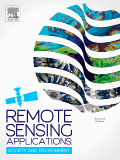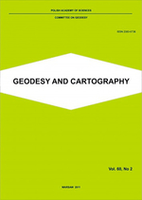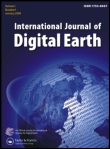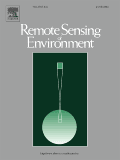
Remote Sensing Applications-Society and Environment
Scope & Guideline
Empowering research that reshapes our understanding of the Earth.
Introduction
Aims and Scopes
- Remote Sensing Methodologies:
The journal emphasizes various remote sensing methodologies, including satellite imagery, UAV (drone) data, and LiDAR, to assess land cover, vegetation health, and environmental changes. - Environmental Monitoring and Assessment:
A core focus of the journal is environmental monitoring, including the assessment of climate change impacts, deforestation, urbanization, and habitat loss through remote sensing techniques. - Socio-economic Applications:
The journal explores the socio-economic implications of environmental changes, including urban heat island effects, land use changes, and their impacts on local communities and economies. - Machine Learning and Data Analysis:
The integration of machine learning techniques for analyzing remote sensing data is a significant area of interest, enhancing the accuracy and efficiency of environmental assessments. - Ecosystem Services and Management:
Research on ecosystem services, including the quantification and management of natural resources, is a key theme, highlighting the importance of remote sensing in sustainable environmental practices.
Trending and Emerging
- Machine Learning Applications:
There is a growing trend towards employing machine learning algorithms to enhance the analysis of remote sensing data, particularly in areas like crop monitoring, land cover classification, and ecological modeling. - Climate Change Impact Studies:
Research focusing on the impacts of climate change on ecosystems and human activities is increasingly prevalent, reflecting the urgent need to understand and mitigate climate-related challenges. - Urbanization and Heat Island Effects:
As urban areas expand, studies addressing urbanization effects, particularly urban heat islands and their socio-economic impacts, have gained significant traction. - Water Quality and Resource Management:
Emerging themes include the assessment of water quality using remote sensing technologies, reflecting global concerns over freshwater resources and pollution. - Biodiversity and Habitat Conservation:
Research on biodiversity monitoring and habitat conservation using remote sensing tools is trending, highlighting the role of these technologies in protecting ecosystems.
Declining or Waning
- Traditional Land Cover Mapping:
There has been a noticeable decline in papers focusing on traditional land cover mapping techniques, as researchers increasingly adopt more advanced methodologies such as machine learning and hybrid approaches. - Basic Environmental Monitoring:
Basic environmental monitoring studies, which do not integrate advanced technologies or interdisciplinary approaches, appear to be less frequent. This reflects a trend towards more complex and comprehensive assessments. - Single Data Source Studies:
Papers relying solely on single data sources for analysis are becoming less common, as the integration of multi-source data is now favored for more robust conclusions.
Similar Journals

Science of Remote Sensing
Pioneering Interdisciplinary Research in Remote SensingScience of Remote Sensing, published by Elsevier, is a premier open-access journal that has been at the forefront of interdisciplinary research since its inception in 2020. With an impressive impact factor and its status in the Q1 quartile category for both Earth and Planetary Sciences and Forestry, this journal effectively caters to a diverse audience, including researchers, professionals, and students interested in the latest developments in remote sensing technologies and their application across varied domains. Located in the Netherlands, the journal provides a collaborative platform for scientific discourse, ensuring that impactful research is easily accessible to the global community. As it converges its focus through to 2024, Science of Remote Sensing continues to promote innovation and excellence, establishing itself as a vital resource for advancing knowledge in both the agricultural and environmental sectors. With a robust ranking (Rank #6 in Forestry and Rank #8 in General Earth and Planetary Sciences), it is well-positioned to contribute significantly to ongoing scientific advancements.

European Journal of Remote Sensing
Shaping the Future of Earth Sciences Through Remote SensingThe European Journal of Remote Sensing, published by Taylor & Francis Ltd, stands as a pivotal resource in the domains of applied mathematics, atmospheric science, and earth sciences. Since its transition to Open Access in 2012, the journal has facilitated unrestricted knowledge dissemination, fostering collaboration and innovation among researchers. With a notable impact factor reflected in its quartile rankings—achieving Q2 in applied mathematics and atmospheric science, and Q1 in miscellaneous environmental science—the journal is a respected platform for high-quality research. Based in the United Kingdom, it encompasses a wide range of topics related to remote sensing technologies and their application in environmental monitoring. Researchers and professionals in these fields will find the journal indispensable for its commitment to advancing scientific understanding and promoting the use of remote sensing methodologies in tackling contemporary environmental challenges.

Revista de Teledeteccion
Exploring the frontiers of satellite technology.Revista de Teledeteccion, published by UNIV POLITECNICA VALENCIA, EDITORIAL UPV, is a leading Open Access journal dedicated to the interdisciplinary field of remote sensing and its applications. Since its inception in 2010, this journal has provided a vital platform for researchers, professionals, and students to disseminate groundbreaking findings, foster collaboration, and engage with contemporary challenges in Earth and Planetary Sciences as well as Geography, Planning, and Development. With a Q3 ranking in both fields as of 2023, it serves as an essential resource for advancing knowledge and innovative practices in hi-tech remote sensing methodologies. The journal covers a broad spectrum of topics, from satellite imaging techniques to environmental monitoring, making it an invaluable asset for those interested in harnessing remote sensing technologies to address real-world issues. The editorial office is located in Valencia, Spain, and the journal aims to bridge the gap between theoretical research and practical application, enriching the scientific community's understanding and capabilities in this dynamic domain.

Geodesy and Cartography
Transforming Spatial Data into Insightful SolutionsGeodesy and Cartography, published by the Polska Akademia Nauk (Polish Academy of Sciences), is a premier open-access journal dedicated to advancing the fields of geodesy, cartography, and geographic information science. Since its inception in 2010, the journal has provided a vital platform for researchers, professionals, and students to share their findings, fostering innovation and collaboration in these critical areas of study. With its ISSN 2080-6736 and E-ISSN 2300-2581, the journal is accessible to a global audience, ensuring that cutting-edge research is readily available to enhance scientific understanding and application. The journal not only serves as a repository of knowledge but also aims to contribute to the development of best practices and methodologies within geospatial sciences, making it an essential resource for anyone invested in the ever-evolving landscape of mapping and spatial data analysis.

METEOROLOGY AND ATMOSPHERIC PHYSICS
Fostering Discoveries in Weather and Climate StudiesMETEOROLOGY AND ATMOSPHERIC PHYSICS is a premier journal published by SPRINGER WIEN, dedicated to advancing the study of atmospheric phenomena and weather-related sciences. With an ISSN of 0177-7971 and an E-ISSN of 1436-5065, the journal has established itself as an important contributor in the field, particularly noted for its contributions in atmospheric science, holding a Q3 ranking in the 2023 category quartiles. Covering a wide array of topics from meteorological modeling to the physics of the atmosphere, it serves researchers, professionals, and students alike, facilitating the dissemination of significant findings and innovative research. The journal’s acceptance of articles until 2024 encourages a continuous influx of knowledge, and despite its lack of Open Access, it plays a crucial role in enriching the academic landscape for those engaged in Earth and planetary sciences, holding a commendable rank of 78 out of 148 in Scopus. Located in the scenic city of Vienna, Austria, the journal is positioned to harness the vibrancy of the academic community, providing a platform for valuable insights that can drive forward the field of meteorology and atmospheric physics.

International Journal of Applied Earth Observation and Geoinformation
Bridging Science and Technology for Global Change.International Journal of Applied Earth Observation and Geoinformation is a premier peer-reviewed journal published by Elsevier, focusing on the integration and application of earth observation and geoinformation technologies across diverse fields. With an open access model established in 2020, this journal enhances accessibility and dissemination of research crucial for addressing global challenges related to climate change, resource management, and sustainable development. The journal occupies a notable position within the academic community, featuring a Q1 ranking in multiple categories including Computers in Earth Sciences, Earth-Surface Processes, and Global and Planetary Change, reflecting its significant impact and relevance in these disciplines. It is recognized for its high-quality articles that explore innovative methodologies and applications, making it an essential resource for researchers, practitioners, and students alike who seek to advance their understanding of earth dynamics and geospatial technology. The journal is indexed in Scopus with impressive rankings that underscore its high citation impact and scholarly influence, with an emphasis on providing a platform for the latest findings in management, monitoring, and policy in environmental science.

International Journal of Digital Earth
Empowering research with open access to geoscience.Welcome to the International Journal of Digital Earth, a premier open-access journal published by Taylor & Francis Ltd, dedicated to advancing the field of digital geoscience. With its ISSN 1753-8947 and E-ISSN 1753-8955, this journal has established itself as a vital resource for scholars and practitioners alike since its inception in 2008. The journal is at the forefront of interdisciplinary research, showcasing a diverse scope from Earth sciences to computer science applications, evidenced by its impressive ranking in the 2023 Scopus database. It holds a Q1 categorization in Earth and Planetary Sciences, with a percentile rank among the top 16% of its peers, and also stands out in the Q2 quartile for both Computer Science Applications and Software disciplines. The journal's commitment to open access, established in 2022, underscores its dedication to disseminating knowledge and fostering collaboration. By providing a platform for high-quality research, the International Journal of Digital Earth plays a critical role in addressing the complexities of our changing planet through innovative digital solutions. Whether you are an experienced researcher or a student, this journal is an essential addition to your academic toolkit.

Chinese Geographical Science
Connecting Scholars to Shape Tomorrow's Geographical Policies.Chinese Geographical Science is a prestigious, peer-reviewed journal published by Springer, dedicated to the dynamic and interdisciplinary fields of Earth and Planetary Sciences and Geography, Planning and Development. With an impressive 2023 Q1 ranking in both categories, the journal supports the dissemination of groundbreaking research from a global perspective, reflecting its significance in the scientific community. The journal is indexed under the highly regarded Scopus database, where it ranks in the top percentile in both Geography and Earth Sciences, illustrating its commitment to excellence and impact within these disciplines. Since its inception in 1991, it has provided a vital platform for researchers and scholars to share their findings, address pressing geographical issues, and contribute to the development of innovative solutions for sustainable development. Although it operates under a subscription model, its rigorous peer-review process ensures that the highest quality of research is published. By fostering collaboration and dialogue among scholars, Chinese Geographical Science plays an essential role in advancing knowledge and shaping policy in geographical sciences and beyond.

REMOTE SENSING OF ENVIRONMENT
Pioneering Research in Earth Observation Technologies.REMOTE SENSING OF ENVIRONMENT, published by Elsevier Science Inc, is a premier academic journal specializing in the interdisciplinary field of earth observation and remote sensing technologies. With an impressive impact factor and classified in the Q1 category for Computer Science in Earth Sciences, Geology, and Soil Science as of 2023, this journal serves as a vital resource for researchers, professionals, and students alike. The journal, which has been disseminating high-quality research since its inception in 1969, provides a platform for the exploration of innovative methodologies and applications in the assessment of environmental changes and resource management through advanced imaging techniques. While not an open-access journal, REMOTE SENSING OF ENVIRONMENT offers access options that make cutting-edge research accessible to its audience. Its strategic focus on critical issues pertaining to environmental monitoring and sustainable practices underscores its role in enhancing our understanding of the planet’s dynamics.

Remote Sensing in Ecology and Conservation
Leading the way in ecological research with remote sensing innovations.Remote Sensing in Ecology and Conservation is a pioneering journal published by WILEY that has been a beacon of open-access research since 2015. With an E-ISSN of 2056-3485, this journal stands at the forefront of the intersection between ecological research and technological innovation. It is recognized for its significant impact, boasting Q1 rankings across several prestigious categories in 2023, including Computers in Earth Sciences and Ecology, emphasizing its commitment to high-quality, influential scholarship. The journal provides a platform for researchers and practitioners to share their findings in remote sensing applications that advance ecological conservation efforts. Encompassing a broad scope that includes studies on landscape changes, biodiversity assessments, and environmental monitoring, it serves as an essential resource for education and practice in the field. With impressive ranks in Scopus, including a remarkable 6th place in Earth and Planetary Sciences, it continues to shape the dialogue in ecology and conservation. As an open-access journal, it champions the dissemination of knowledge, making critical research accessible to a global audience, thereby fostering innovation and collaboration in the pursuit of sustainable environmental practices.